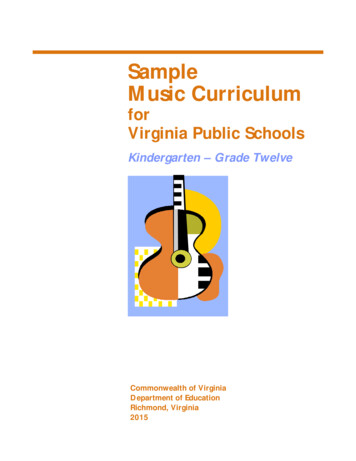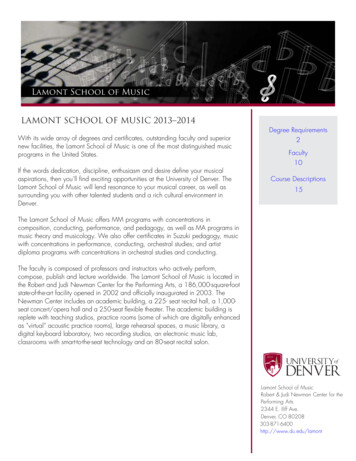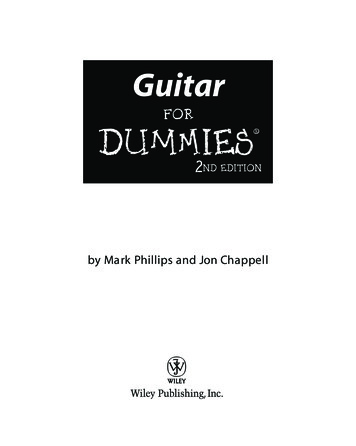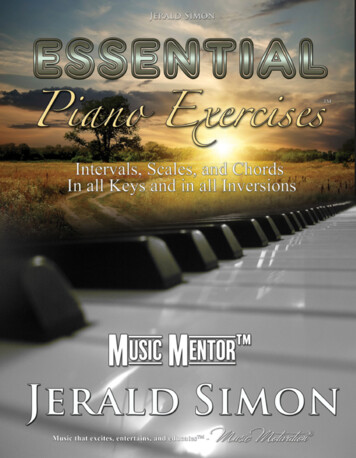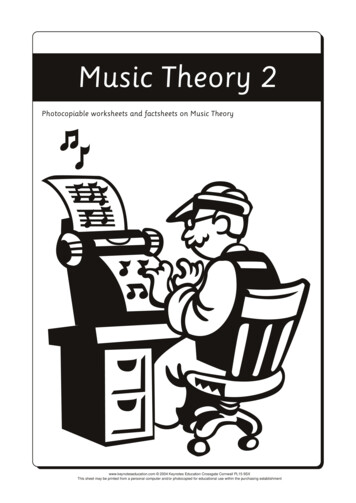
Transcription
Music Theory 2Photocopiable worksheets and factsheets on Music Theorywww.keynoteseducation.com 2004 Keynotes Education Crossgate Cornwall PL15 9SXThis sheet may be printed from a personal computer and/or photocopied for educational use within the purchasing establishment
Name:Music Theory 2 Worksheet1ALTO CLEFA clef fixes the pitch of notes on the stave. The alto clef is centred around the middle or 3rdline of the stave. This middle line tells the performer where the note middle C is found in thisclef. Another name for the alto clef is the C clef.CaaaThe main reason for using the alto clef is thatit helps to avoid too many leger lines whenwriting music for instruments that frequentlyuse the lower notes in treble clef and thehigher notes in bass clef.middle COriginally the alto clef was used forthe alto voice but is now commonlyused for the viola.As you can see the range of the violaextends from the C below middle Cright up to the C two octaves abovemiddle C. This makes the alto clefconvenient to use as the most usualnotes played falls in the middle ofthis range.wViola rangeC w :AaaaaaaaaaaaaPractise drawing the alto clef onthe empty stave.2yuiop[]\as2o[\ayisup]FGABCDEFGAWrite down the names of the notes below. 444444444444444Now rewrite these notes in treble clef at pitch. Watch out for the leger lines!www.keynoteseducation.com 2004 Keynotes Education Crossgate Cornwall PL15 9SXThis sheet may be printed from a personal computer and/or photocopied for educational use within the purchasing establishment
Name:Music Theory 2 Worksheet2TENOR CLEFThe tenor clef is centred around the 4th line of the stave. This 4th line tells the performerwhere the note middle C is found in this clef. Another name for the tenor clef is the C clef.346middle CThe most common instruments thatuse the tenor clef are the cello,bassoon and trombone.As with alto clef, using the tenor clef helps to avoidhaving to use too many leger lines. This wouldhappen when writing for instruments that have arange from the bass clef up to the lower end ofthe treble clef and so the tenor clef is used instead.You can see from the diagram thatthe range of the cello extends fromthe C two octaves below middle Cright up to top G in the treble stave.This makes the tenor clef convenientto use as the most usual notes playedfalls in the middle of this range.w1w44444444:ACello rangePractise drawing the tenor clef onthe empty stave.w3yuiop[]4as3pyi[\uoa]sDEFGABCDEFWrite down the names of the notes below. 444444444444444Now rewrite these notes in treble clef at pitch. Watch out for the leger lines!www.keynoteseducation.com 2004 Keynotes Education Crossgate Cornwall PL15 9SXThis sheet may be printed from a personal computer and/or photocopied for educational use within the purchasing establishment
Name:Music Theory 2 Worksheet3TRANSPOSITIONTransposition in music simply means changing the pitch of a piece of music without altering therelation of one note to another. If you look at the extracts below you will see that although thefirst one is in C major the intervals have stayed the same when it has been transposed up atone into D major. The major thirds in the accompaniment are still major thirds in the transposedextract. The minor third in the melody line is still a minor third in the transposed extract.minor 3rdmajor 3rdminor 3rdIf you need to transpose a piece of music the most important thing to remember is that youmust keep all the intervals the same as the original. It is particularly easy to forget to add anecessary accidental. If the key signature hadn’t been transposed in the extract above it mighthave been easy to forget the F and C sharps.On the empty stave below transpose the melody line of the C major extract down a tone.Try this with the key signature written in and then without using accidentals.On a separate piece of manuscript paper try writing out both parts a tone lower.The new key seducation.com 2004 Keynotes Education Crossgate Cornwall PL15 9SXThis sheet may be printed from a personal computer and/or photocopied for educational use within the purchasing establishment
Name:Music Theory 2 Worksheet4MODESThe origins of the major and minor scales we know today can be traced back to the Greeks.They are called Ionian and Aeolian. The Greeks also had several other different scales apartfrom those now comonly used in Western music. They named these scales after different tribesand the principal scales were Dorian, Phrygian, Lydian and Mixolydian. These scales all hadindividual characteristics of whole tones and semitones. These tones and semitones were fixedin descending order and each had a related scale which started a fifth below the main scale.These scales were given the prefix hypo which means phrygianMixolydianHypomixolydian \][poiuy [poiuytr ][poiuyt poiuytreEarly Christian musicians took these Greek scales and called them modes. The word modeactually means manner. These musicians ran the scales in ascending order starting on D, E, Fand G. This changed the notes used dramatically. Compare the Greek scales above with themodes below.DorianLydianPhrygianMixolydian tyuiop[] uiop[]\a yuiop[]\ iop[]\asWrite the correct modes below.PhrygianDorianMixolydianLydian 44444444 44444444 44444444 44444444www.keynoteseducation.com 2004 Keynotes Education Crossgate Cornwall PL15 9SXThis sheet may be printed from a personal computer and/or photocopied for educational use within the purchasing establishment
Name:Music Theory 2 Worksheet5DEMISEMIQUAVERSAs you already know in music there are particular note shapes used to represent different timevalues. Demisemiquavers are very quick notes. If you look at the note pyramid below you canclearly see their value in relation to a semibreve.hw1 semibrevehK K K KLLLLLLLLMMMMMMMMMMMMMMMM2 minims4 crotchets8 quavers16 semiquaversNNNNNNNNNNNNNNNNNNNNNNNNNNNNNNNN32 demisemiquaversThese very quick notes aren’t so common in music but usually occur as a result of double dotswhich can reduce the beat to smaller divisions. An even quicker note called a hemidemisemiquaverexists and there are 64 hemidemisemiquavers to one semibreve!A demisemiquaver rest looks like a semiquaver rest with an extra tail.Answer these questions true or false.YOne minim is worth 16 semiquaversTwo quavers are equal to 8 demisemiquaversThere are 32 semiquavers in one semibreveThere are 24 demisemiquavers in a dotted minimOne crotchet is equal to two quavers or eight demisemiquaversNow see if you can work out the answers to the questions below.KKKK KK L K K K K K K K K K K K K K K K K Kcrotchets K minimswww.keynoteseducation.com 2004 Keynotes Education Crossgate Cornwall PL15 9SXThis sheet may be printed from a personal computer and/or photocopied for educational use within the purchasing establishment
Name:Music Theory 2 WorksheetTHE BREVE642A breve is worth twice as much as a semibreve. This means that it is equal to eight crotchets.It is most commonly found in early music or some hymns which use the time signature of .Strangely, the word breve comes from the medieval period, where it actually meant a short note.Over the centuries this has changed to mean the opposite.The breveA breve looks similar to a semibreve but has a line eitherside of the note. Sometimes it is also drawn with twolines on each side.orThe breve restThe breve rest is written between the third and fourthlines of the stave and is a small rectangle which sitson the third line. A breve rest is used to indicate awhole bars rest in the time signature of . For everyother time signature a whole bars rest is indicated bya semibreve rest.A German Chorale melody using a breve.44454442Fill in the chart below.brevebreve verNsemidemisemiquaver restquaverrest544 544 544 544 544 544 544www.keynoteseducation.com 2004 Keynotes Education Crossgate Cornwall PL15 9SXThis sheet may be printed from a personal computer and/or photocopied for educational use within the purchasing establishment
Name:Music Theory 2 Worksheet7BEAMINGBeaming is simply the musical term for grouping notes together.The clearest way to beam notestogether is to think of what will be the easiest to read when playing the music. The clearest3division is usually by the main beat. In a simple time signature like 4 this might mean grouping9notes into crotchet beats. In a compound time signature such as 8 this might mean groupingnotes into dotted crotchets.Compare the two short extracts below. In the first all the notes are written separately. Whilstyou can read the music of the first extract it is not so easy to see where the beat is. In thesecond you can see that the groupings make it much easier to read and count.( 4RQRRR KQLMKLLL4MLLLAaaaaaaaaaaaaaaWhen writing music remember that with notes below the middle line, the note tails are on theright pointing upwards, and that notes above the middle line have tails on the left pointingdownwards. The middle line itself can have tails going either way. It is usually best to put thetail of the notes on the middle line going the same way as the majority of notes in that bar.Equally, if you have one note in a group which crosses over the middle line beam it with themajority of the other notes in its group. Avoid using tied notes unless you really need to. Theyare usually used when a note is sustained from one bar to the next.( 6QRQ.L K.QLLLQQ8LLML.ALaaaaaaaaaaaaaaRewrite the extract below with the correct beaming. 6A8aaaaaaaaaaaaaawww.keynoteseducation.com 2004 Keynotes Education Crossgate Cornwall PL15 9SXThis sheet may be printed from a personal computer and/or photocopied for educational use within the purchasing establishment
Name:Music Theory 2 Worksheet 8DOUBLE DOTSA dot after a note means that it is held for the original value plus half as much again.A semibreveww. w h 4 crotchetstherefore a dotted semibreve 4 6 crotchets2A double dot means that you add half the value plus half the value again.Therefore a double dotted semibrevew. w h q 4 7 crotchets 2 1See if you can work out the value of these notes. Circle the correct answer.q.h.A double dotted crotchetA double dotted minim 7 semiquavers 4 quavers5 semiquavers7 quavers9 semiquavers8 quaversWrite down the answers in the spaces provided.A double dotted quavere.w.A double dotted semibreve demisemiquavers quaversAdd in the double dots where needed to makes these bars complete.www.keynoteseducation.com 2004 Keynotes Education Crossgate Cornwall PL15 9SXThis sheet may be printed from a personal computer and/or photocopied for educational use within the purchasing establishment
Name:Music Theory 2 Worksheet9MUSICAL TERMS FACTSHEETThis quick reference page contains a selection of some of the most common musical terms andsymbols along with their meanings.TEMPOOTHER TERMSlargoslow and statelyrf or rfzlarghettoslightly quicker than largo(rinforzando)lentovery slowfz (forzando)with forceadagioslowandantewalking speedsf or sfzloudly accentedandantinoquick walking speedmoderatomoderate speedallegrettoquite fastallegrofast and livelyprestofastprestissimovery fastheavily accented(loudly accented)D.C. (da capo)go back to thebeginningD.S. (dal segno)signten. (tenuto)CHANGING TEMPObgo back to thehold the noteDYNAMICSaccelerandoget fastermolto pianissimo pppextremely quietritardandogradually slowdowngradually slowdownpianissimoppvery quietpianopquietrallentando(rall.)mezzo pianompquite quietmfmoderately loudallargandobroadermezzo forteritenuto (rit.)slow downfortefloudpiu mossomore movementfortissimoffvery loudmeno mossoless movementmolto fortissimofffextremely louda temporeturn to theprevious speedreturn to theoriginal speedcrescendo gradually get louderdiminuendo gradually get quietertempo primowww.keynoteseducation.com 2004 Keynotes Education Crossgate Cornwall PL15 9SXThis sheet may be printed from a personal computer and/or photocopied for educational use within the purchasing establishment
Name:Music Theory 2 Worksheet 10METRONOME MARKINGS & TEMPO INDICATIONSThe metronome was invented by a man named Maelzel who lived from 1772-1838. It wasdesigned to ensure that strict time was kept when playing a piece of music. Early metronomeswere wound up and then ticked like a clock at a steady beat set by moving a sliding bar up anddown. When you see a metronome marking it is usually written like this: M.M. q 60 . Thismeans that there are 60 crotchet beats in one minute. This would be equal to one crotchetevery second. The M.M. stands for Maelzel’s Metronome.Today metronomes come in all shapes and sizes but the basic principal is the same. Using ametronome when practising can be a useful method of making sure that you keep accuratetime. Equally, if you are composing, adding a metronome marking can help to ensure that themusic is performed at the correct speed, as it is more precise than simply writing adagio,andante, allegro etc.The beat indicated by a metronome does not have to be a crotchet. Sometimes you may wishto indicate the beat of minims or quavers. These would follow exactly the same format but thecrotchet would be replaced by the note value you want to use. Below are two examples.M.M. e 4444 quavers in one minuteM.M. h 5656 minims in one minuteThe number of beats per minute roughly correspond to the different musical terms as shownin the table.Work out the musical term that correspondsq 40 - 60largoto each tempo indication.larghettoq 60 - 66M.M. q 64q 70 - 76M.M. q 120q 66 legroq 76 - 90q 90 - 108q 108 - 116q 116 - 125prestissimoM.M. q 86q 125 - 168M.M. q 132q 200 - 208M.M. q 100q 168 - 200prestoM.M. q 144www.keynoteseducation.com 2004 Keynotes Education Crossgate Cornwall PL15 9SXThis sheet may be printed from a personal computer and/or photocopied for educational use within the purchasing establishment
Name:Music Theory 2 Worksheet 11IRREGULAR TIME SIGNATURESA time signature fixes the number of beats found in each bar. We are used to time signaturesusing duple, triple or quadruple time. The time signature helps us to see where the strong andweak beats fall in the bar. In irregular time signatures the number of beats in a bar are usuallyin groups of five or seven (quintuple or septuple). It is perhaps easiest to think of them as acombination of duple and triple time. For example 3 2 5, 3 4 7, or 2 3 2 7. Thenotes are grouped to reflect these combinations. In theory you can choose any number of beatsin the bar. However, in practise composers tend to use five, seven or occasionally eleven.More than this becomes very difficult to read.Irregular time signatures are very common in eastern European and Asian music. Composerssuch as Stravinsky and Bartók frequently used irregular time signatures in their music. Bartókin particular was strongly influenced by Hungarian folk music and often used folk tunes andrhythms in his compositions.54The English carol This is the truth sent from above is written in time. Try singing it toyourself and see how the words and music naturally fall into a pattern of 2 3.etc.Occasionally you might see a dotted bar line dividing part of a bar in an irregular time signature.This is to clarify where the composer wishes the accents to fall.Answer the questions below.5452meanscrotchets in a barmeansminims in a bar7472meanscrotchets in a barmeansminims in a barNow try to identify the time signature in this extract.www.keynoteseducation.com 2004 Keynotes Education Crossgate Cornwall PL15 9SXThis sheet may be printed from a personal computer and/or photocopied for educational use within the purchasing establishment
Name:Music Theory 2 Worksheet 12DUPLETSA duplet, like a triplet, is an irregular note group. A triplet is three notes played in the time itwould usually take you to play two. It is found in music written in simple time where the beatscan be divided by two. A duplet is the opposite, two notes played in the time it would usuallytake you to play three. It is found in compound time signatures.This is easiest to understand by looking at the two extracts below.68 consists of two dotted crotchets.The duplet 34 consists of three crotchet beats. The triplethas two quavers played in the time it wouldnormally take you to play three quavershas three quavers played in the time it wouldusually take you to play two.If you are playing a triplet or duplet divide them equally in proportion to the main beat. Usinga slur or a square bracket above the notes that are part of the duplet or triplet make it easierto read.Study the extracts below and add in the duplet or triplet signs where needed to make thebars add up correctly.Now tr y and compose two four bar phrases one in simple time using a triplet figure andone in compound time using a duplet figure. 44444444444444444 44444444444444444www.keynoteseducation.com 2004 Keynotes Education Crossgate Cornwall PL15 9SXThis sheet may be printed from a personal computer and/or photocopied for educational use within the purchasing establishment
Name:Adding a sharpDMusic Theory 2 Worksheet 13DOUBLE SHARPSto a note raises it one semitone.HA double sharp raises a note two semitones which is equal to one whole tone. A double sharplooks rather like a cross .If you look at the piano keyboard below you can see that Gthe note G and actually sounds the note A.His one whole tone higher thanG naturalFDDG double sharp (sounds A natural)If you want to cancel a double sharp use a single sharp sign . Although some composers usea natural sign followed by a single sharp like this. Double sharps are usually only found inkeys that already have several sharps.Try drawing in a double sharp before each of these notes. Make sure it is in the space oron the line that you want to apply it to! 55i55t55p55e55o55]55yIn the scale of G sharp harmonic minor the leading note becomes F double sharp. This is becauseF sharp is already found in the key signature and so to raise this seventh note half a step higherrequires the double sharp.DDDDH 44i5o5p5[5]5\5a5s5 66 6 6 6 6 6 6 6 6 6 6 6 6 6 6 6 6 6 6 6 6 6 6 6 6 6 6 6DRewrite this scale out using accidentals and not the key signature.www.keynoteseducation.com 2004 Keynotes Education Crossgate Cornwall PL15 9SXThis sheet may be printed from a personal computer and/or photocopied for educational use within the purchasing establishment
Name:Adding a flatEMusic Theory 2 Worksheet 14DOUBLE FLATSto a note lowers it one semitone.GA double flat lowers a note two semitones which is equal to one whole tone. A double flatlooks like two flats joined together .If you look at the piano keyboard below you can see that Bthe note B and actually sounds the note A.Gis one whole tone lower thanB double flat (sounds the note A)FEEB naturalIf you want to cancel a double flat use a flat sign . Some composers use a natural sign followedby a single flat like this . Double flats are usually only found in keys that already have severalflats.Try drawing in a double flat before each of these notes. Make sure it is in the space oron the line that you want to apply it to! 55i55t55p55e55o55]55yAnswer these questions.B double flat sounds the noteC double flat sounds the noteF double flat sounds the noteG double flat sounds the noteD double flat sounds the noteE double flat sounds the noteA double flat sounds the notewww.keynoteseducation.com 2004 Keynotes Education Crossgate Cornwall PL15 9SXThis sheet may be printed from a personal computer and/or photocopied for educational use within the purchasing establishment
Music Theory 2 Worksheet 15Name:AUGMENTED AND DIMINISHED INTERVALSAn augmented interval occurs when a perfect or major interval is made a semitone bigger. Adiminshed interval occurs when a perfect or minor interval is made a semitone smaller. Thechart below shows all the intervals available up to an octave starting on the note entedIntervalsDiminishedIntervals 55rr55 55r5555 55r5555 55r5555 55r5555wE wDwEw 555 5 555 5 555 5 555 5 555 5wwwwE wwD wwEwwTry to recognise the intervals below.Use the keyboard to help you. It may helpto work out the number of semitones ineach interval and always include the notesyou start and finish on! 555 5 555 5 555 5 555 5 555 5 555 5 555 5 555 5 555 5 555 5wwwwwwwwEwEwwwDwDwwwGwGwwwG A B C D E F G A B C D EwDw 555 5 555 5 55r5555 555 5 555 5wwD wwwwwww 555 5 555 5 5555555 555 5 555 5D wwEwwwwwww.keynoteseducation.com 2004 Keynotes Education Crossgate Cornwall PL15 9SXThis sheet may be printed from a personal computer and/or photocopied for educational use within the purchasing establishmentww
Music Theory 2 Worksheet 16Name:CHROMATIC SCALESIf you start on the note C and play all the notes from C up to the C an octave above you geta pattern of twelve semitones, this is called a chromatic scale. A chromatic scale can go upor down and start on any note. Usually when writing a chromatic scale the notes are sharpenedon the way up and flattened on the way down. The word chromatic actually means colouredand the scale is often used to add colour in a piece or to demonstrate a performer’s technique.It was particularly popular during the Romantic period. rrttyuuiioop[ppooiiuyyttrDDDDDEEEEWrite an ascending chromatic scale starting on D.E t44444444444444 a44444444444444 444444444444444 444444444444444Write a descending chromatic scale starting on F.Write an ascending chromatic scale starting on G.Write a descending chromatic scale starting on E.www.keynoteseducation.com 2004 Keynotes Education Crossgate Cornwall PL15 9SXThis sheet may be printed from a personal computer and/or photocopied for educational use within the purchasing establishment
Name:Music Theory 2 Worksheet 17CHORD INVERSIONA chord is a group of three or more notes played together. Three notes played together formwhat is known as a triad. There is a triad for every note in every scale. These triads are madeup from the starting note plus the note a third above, plus the note a fifth above the startingnote. Below you can see the triads formed in the key of C major.wwwwwwwwwwwwwww1VVV1V11I 55554444444444444444455www1www11www111When you play a piece of music the notes of the triad are not always arranged in the same order.This is called inversion. If you look at chord I in C major there are three main positions for thenotes. These three positions are called root position, first inversion and second inversion. If youare using Roman numerals these positions become a, b and c. The important note when workingout the inversion is the bottom note as this tells you which inversion the chord is in. Checkwhether it starts on note 1, 3 or 5 of the chord.ww5wwww 5555444444455 5555444444455ww3www1 wrootpositionon C (1)firstinversionon E (3)secondinversionon G (5)wwwChord 1awww1b1cin C majorSometimes when writing a chord in root position the a is dropped as everyone knows it is aroot position chord. In the chord above it would be equally correct just to write 1 rather than1a.Try to work out these chord positions. Write them down in Roman numerals. The firstone is done for you. They are all in the key of C major. 555545 555545 555545 555545 555545 555545 555545 tion.com 2004 Keynotes Education Crossgate Cornwall PL15 9SXThis sheet may be printed from a personal computer and/or photocopied for educational use within the purchasing establishment
Name:Music Theory 2 Worksheet 18SEVENTH CHORDS - DOMINANT SEVENTHMany common chords are simply made up from triads which use the root note plus the thirdnote, plus the fifth note. To make chords a little more interesting or unusual sometimes composersadd in the seventh note. The most common seventh chord is the dominant seventh. This soundshorribly complicated but is really quite straightforward. The fifth note of the scale is called thedominant. If you are in C major the dominant would sound the note G. The dominant seventhin C major is a chord built on this G. The dominant seventh starts off the same as any triad usingthe starting note plus the third note, plus the fifth note but then adds on the seventh note. Thismeans you end up with the notes G, B, D and F.wwww 555545dominant seventhchord in C majorJust as we use Roman numeralsfor ordinary triads you can dothe same for dominant sevenths.This chord in C major would bewritten like this:wwww 555545V7In ordinary triads if we change the position of the chord indicate it by saying root position, firstinversion or second inversion. If we are using Roman numerals we might say a, b or c. In a chordlike a dominant seventh which has four different notes we simply add in third inversion and inRoman numerals the letter d.wwwwwwwwwwwwwwww 555545 555545 555545 ersionV7dthirdinversionWrite the four positions for the dominant seventh chord in G major and D major.The first one has been done for you. 55”55545 55”55545 55”55545 55”55545 55”5È545 55”5È545 55”5È545 55”5È545wwwwV7awww.keynoteseducation.com 2004 Keynotes Education Crossgate Cornwall PL15 9SXThis sheet may be printed from a personal computer and/or photocopied for educational use within the purchasing establishment
Music Theory 2 Worksheet 19Name:MODULATIONIf music always stayed in the key it started in it would be rather boring to listen to. Most piecesmove to a new key at some point even though it will usually work its way back to the originalkey by the end of the piece. This is called modulation. The word modulation comes from theLatin verb to adjust.The easiest way to change key is by using a pivot chord. A pivot chord is one that is found inboth the old key and the new key.The C major tonic chord based on the note C could also beseen as the dominant chord in F major, or the subdominant chord in G major. If you wantedto move to the key of G from C major you could treat the C major chord as the subdominantin the new key. Use this chord to then move to the dominant in the new key (a D major chord).From there you can move easily to the tonic chord of G.See how the note C relates to the different keys in the scales below.Tonic in CSubdominant in GDominant in F rtyuiop[ iop[]\”as uioŸp[]\aStudy the extract below and see how Bach changes the key from A major to E Major by usingthe dominant chord in A major (E major) as the tonic chord in the new key. By adding in theD sharps which are found in the new key, Bach fixes E major as the new tonic key. Introducingflats or sharps that are found in the new key are a great clue to modulation. Write them downin order to help you work out the new key.Work out what key this piece modulates to before returning to the original key.Key:Key:Key:www.keynoteseducation.com 2004 Keynotes Education Crossgate Cornwall PL15 9SXThis sheet may be printed from a personal computer and/or photocopied for educational use within the purchasing establishment
Name:Music Theory 2 Worksheet 20PASSING AND AUXILIARY NOTESA passing note as the name suggests doesn’t form a part of a chord it just passes between noteswhich are found in the harmony chords, linking them together. Passing notes are usually foundon the weak beats of the bar and move by step. The passing note always falls between two notesmoving in the same direction and can occur in any voice part.Bach passing noteAn accented passing note falls on the strong beat of the bar but unaccented passing noteswhich fall on the weak beat of the bar are more commonly used.unaccentedpassing noteAn auxiliary note is writtenbetween two notes of the samename. An upper auxiliary notemoves one step higher than theoriginal note and then returns to itand a lower auxiliary note movesone step lower than the originalnote and then returns to it. Anauxiliary note can either move atone or a semitone.accentedpassing noteupperauxiliary noteslowerauxiliary notesFind the passing and auxiliary notes in the extractbelow. Write P for the passing notes and A for theauxiliary notes.www.keynoteseducation.com 2004 Keynotes Education Crossgate Cornwall PL15 9SXThis sheet may be printed from a personal computer and/or photocopied for educational use within the purchasing establishment
Music Theory 2 Worksheet 21Name:SIGNS FOR REPETITIONOften in music you will find various signs for repeating sections of a piece. This means thatrather than writing out every repeat and adding many pages to the score you simply follow thesigns. There are various signs in music to show that the music needs to be repeated. These maybe used to show a repeat of a whole piece, a section or even particular musical notes in a bar.These vary quite widely and some are easier to work out than others!If you want to repeat one section exactly then drawing a double bar line with two dots eitherside of the middle line is the easiest way. Place one where you are starting the repeat and theother in the bar where you want the repeat to stop. Usually this is at the beginning and end ofthe bar but it can be put anywhere in the bar. You will still need to add in the barline if it ismidway through the bar to make the bar add up correctly. If you are repeating back to thebeginning of a piece then you can leave out the first set of dots.55555555555{repeat between these two points55555555555{If the music changes the second time through you will need to draw in a first and second timebar, so that the performer knows where the music goes to. This is shown in the example below.144.2 5()vv5bWQ F55 (5}A first and second time bar can extend over one or more bars and you simply extend the lineto show how many bars.gSometimes in music you see the words Da Capo or D.C. for short. This means
Music Theory 2 Photocopiable worksheets and factsheets on Music Theory. . The minor third in the melody line is still a minor third in the transposed extract. major 3rd minor 3rd . See if you can work out the value of




